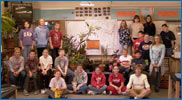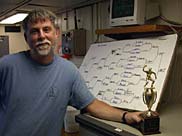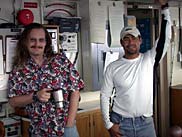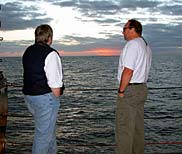|
|
|||||||||||||||||||||||||||||||||||||||||||||||||||||||||||||||||||||||||||||||||||||||||||||||||||
 |
|||||||||||||||||||||||||||||||||||||||||||||||||||||||||||||||||||||||||||||||||||||||||||||||||||
Only one more day to go… In some ways it seems like only yesterday that I was writing “only one more day until we get on site and start our science.” Half way through the cruise, many of us felt like it was never going to end, and now that our bags are nearly packed it seems like we barely left port in Barbados. I don’t have the opportunity to sail often, but when I do, the final days of a cruise always leave me with mixed emotions. On the one side, I am excited about getting back to solid ground, my family, and my own bed. On the other hand, there is a melancholy feeling of admitting that the expedition is over and it is time to leave the group and the intensive scientific interaction that we have had.
We all feel that our expedition to the Lost City vent field has been an incredible success. One of the exceptional things about this project is the mix of diverse scientific disciplines and technological advancements. The ABE team has produced amazing bathymetric and 3D maps that delineate the vent field and help us understand the tectonic and erosional processes that may control hydrothermal circulation and venting. Through their skill and patience, the Alvin pilots have helped collect the samples we need for our studies of the rocks, biology, geology, fluid chemistry, and organic geochemistry of the Lost City hydrothermal field. We are also greatly indebted to the tremendous work of the ship’s crew, who has made sure that we got where we needed to go, had plenty of good food, and a safe working environment. Teamwork all the way around has led to a phenomenal amount of imagery, samples and data that we are taking home with us. One of my jobs was to keep a log of all the different samples we collected during our expedition. In the end, we had 19 Alvin dives, on which we collected a total of 114 rock samples, 173 vent fluid samples, and 41 macrofaunal samples! From these, 153 microbiological samples were taken. ABE was busy as well, covering a distance of 200 km during 17 missions.
A number of the K-12 students have sent us questions asking how we became scientists, if we enjoy our work and why are we doing these studies. The easiest answer is because it is exciting work and at times can be quite fun! Curiosity and an interest in natural sciences is probably the common denominator in all of our disciplines. We all have an interest in understanding how Earth as a whole works and how it supports plants and life. Many of us are also driven by the challenge of discovering new things. Having the opportunity to work on an international, interdisciplinary project like this one and being in an area where we can do pioneer work has been a major motivation for our team.
I think one of the ways we can judge the success of our efforts here is that fact that we are all excited to go back to our home institutions and work on the samples we have collected. I was present when we first discovered the Lost City field and I don’t think I will ever forget our excitement that night. Many of us will be leaving the ship with a similar type of excitement. In some ways, we may have opened up more questions than we originally had. However, the type of sampling we were able to do, together with the fabulous ABE maps will help us understand much better how seawater gets into the basement rocks, how it reacts along the way, and how the fluids provide nutrients for the microbial communities, who in turn provide food for the macrofaunal species we have seen. I am sure I am not alone in feeling very privileged to have been part of the scientific team and to have had the opportunity to see the indescribably beautiful structures that Nature has created on the seafloor here. The success of our cruise – and the possibly to share this success with all of you on land – lies so much in the tremendous efforts of our chief scientist, Debbie Kelley. Deb, we would all like to sincerely thank you for the long days and sleepless nights you put into writing the proposal, putting together the scientific team, preparing the trip, and guiding us through this expedition. Mission accomplished – yes, and only superlatives to describe it!! |
|||||||||||||||||||||||||||||||||||||||||||||||||||||||||||||||||||||||||||||||||||||||||||||||||||




